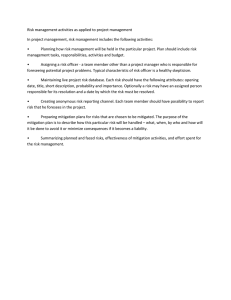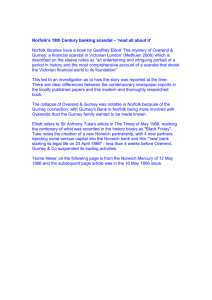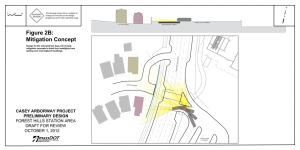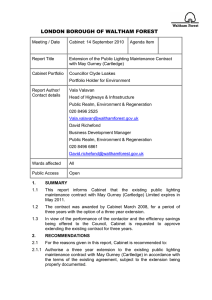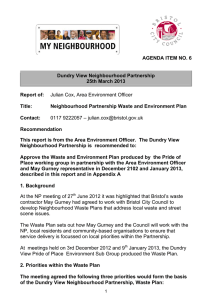Document 17805736
advertisement
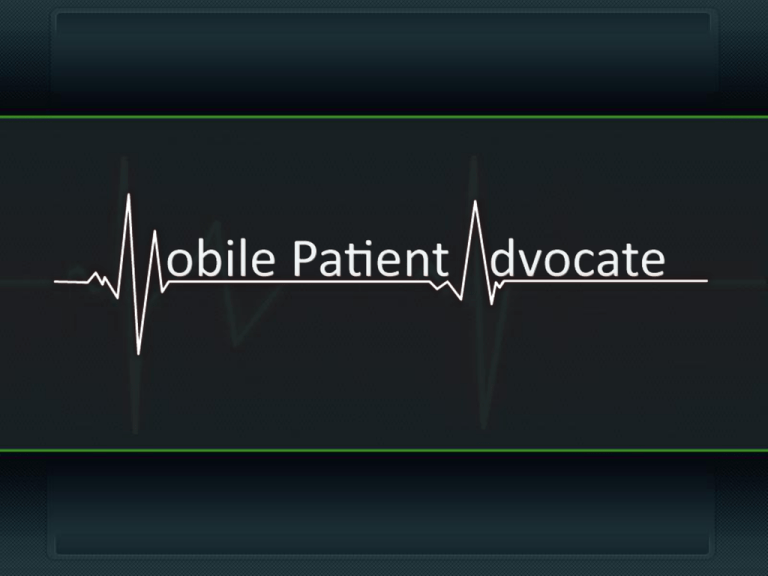
Orange Team CS 410 Spring 2009 Presented by: Jonathan Kriebel 02 April, 2009 1 Team ORANGE Project Manager Documentation Software Noah DiCenso Chris Norton Jonathan Kriebel Hardware Marketing Finances/Risk Mgt. Kevin Tindall Jamil Pickett Generoso Nunez 02 April, 2009 2 So What’s the Problem? A viable, practical, and Mobile solution for conveyance and tracking of Patient Medical Information is needed within the hospital environment! 02 April, 2009 3 Who Does It Affect? Patients • Concerned with current medical status • Uncomfortable awaiting scheduled procedures, tests, etc. Families • 02 April, 2009 Concerned with medical status of loved ones 4 How is the Medical Establishment Affected? Doctors and Nurses • Often must repeat instructions, etc. for concerned family Hospitals • Helps reduce malpractice - patient conveyance of info is recorded - and can show that the patient did not divulge important facts • Uninformed families seeking information impede efficient hospital operations 02 April, 2009 5 How is the Medical Establishment Affected? Communication • Patients/families should have access to up to date medical information Coordination • Better patient care can be arranged if patients/families are “in the loop” Cooperation • Patients/family are better care partners with access to up to date medical information 02 April, 2009 6 Who benefits the most from our solution? Use the device • People who frequent the hospital • People who require longer term care 02 April, 2009 View results remotely • Elderly • Children • Terminally ill • Patient’s families • Concerned loved ones 7 Market Defined • Hospitals Can help to mitigate persistent problems between patients/family and doctors/nurses in a way that is meaningful. • Nursing Homes Can provide the perfect environment for the mobile advocate because of the increased emphasis on a closed medical environment. 02 April, 2009 8 Proposed Solution A mobile device that will allow Patients and their families to centrally store and access up to date information about the patient’s current medical and treatment status. 02 April, 2009 9 Solution Capabilities Voice Recording • Audio Recording of Doctor/Patient Notes Electronic ID Detection • Identifies Patient • Identifies Medical Personnel Manual Text Entry • Supports Conventional Note Taking • Patient tracking/scheduling • Tracks current patient location in hospital • Maintains list of pending tests/procedures 02 April, 2009 10 Through the door… 1. Patient checks in to hospital and rents device 2. Doctor/Nurse visits • Patient can scan Dr/Nurse id with device • Patient can record pertinent notes for later review 3. Doctor schedules procedure • Patient can view list of outstanding procedures • Patient is notified when gurney man is en route 02 April, 2009 11 …to the procedure lab… 4. Patient on Gurney • Patient’s location track updated to which gurney and time 5. Patient arrives at procedure lab • Patient’s location track updated with location and time • Any pertinent discussion with lab technicians, etc. can be recorded 02 April, 2009 12 …back to the room… 6. Patient on Gurney • Patient’s location track updated to which gurney and time 7. Patient Back in Room • Patient’s location track updated with location and time 8. At the end of the day • Results stored to server for later potential review • Results are deleted to maintain privacy 02 April, 2009 13 …and out the door! 9. Patient is discharged • Patient has option of saving electronic recordings and tracks • Data is wiped from device and server 02 April, 2009 14 What it will do • Will allow patient and family members to access pertinent medical data • Will track patient tests/procedure, etc • Will notify patients when gurney man is en route to transport patient to test/procedure • 02 April, 2009 Will Not Replace the Medical Record 15 Benefits Improved: • Efficiency of Patient Data Management • Patient Tracking • Patient Care • Patient and Family Advocacy Reduced: • Medical Malpractice Lawsuits (Potentially) Increased: • Interoperability for Medical Staff and Patient/Family as care partners 02 April, 2009 16 Component Diagram (MFCD) Remote client Wireless access point Internet Mobile device Remote client Application server Wireless control server RFID Database 02 April, 2009 17 Hardware issues Patient created content – Security • Data needs to be protected from unauthorized access • Ensure device to server and device to person security – Space on mobile device • Requires large amount of space on device – Voice data – Scheduled events – Basic vitals 02 April, 2009 18 Hardware “The Bones” Mobile Device • Interfaces with Server • Identifies medical staff • Receives alerts • easy to use - simple push of record and pause, etc for very ill patients Wireless access points • Provide coverage for mobile device throughout the hospital campus • Supports encryption to be HIPAA compliant 02 April, 2009 19 Hardware continued Servers • Provide access control and authentication to the wireless network • Host the database servers which contain patient and user information 02 April, 2009 20 Software "The Brains" Mobile Device Software • Java Interface Database • Provide coverage for mobile device throughout the hospital campus • Supports encryption to be HIPAA compliant 02 April, 2009 21 Website features Secure Login • SSL using latest encryption • Secure data access • Role based security for various family members Access to patient created data • Audio file storage for limited time • Patient tracking updates 02 April, 2009 • View scheduled procedures • View completed procedures 22 Risk Matrix P R O B A B I L I T Y IMPACT Negligible Minor Moderate Serious Unlikely T1, T3, T4 M2, L1, L2 Possible M1 T2 Major Highly-Unlikely Higly-Likely Inevitable 02 April, 2009 23 Risk Matrix Legend Item Technological Risk Probability Impact T1 Website Outage 2 3 T2 Data Security 3 4 T3 Device Malfunction 2 3 T4 Hospital Process Integration 2 3 Item Legal Risk Probability Impact L1 HIPPA Violations 2 4 L2 Hospital Lawsuit Risk 2 4 Item Market/Financial Risk Probability Impact M1 First to Market 3 3 M2 Doctor’s Approval 2 4 02 April, 2009 24 Competition Matrix Prognosis eCare Aware Gateway MedProtocal Designer eClinicalWorks AccuNurse MPA Secure –HIPPA Compliant x x x x x x x Role Based Security x x x x Accuracy of Data x x x x Electronic Patient Identification x x x x x Real-time data x Mobile x Complete x x x x x x x x x x x x x x x x x Adaptability to current systems x Low cost x Simple to use x Alerts provided x x x Patients perspective 02 April, 2009 x 25 Potential Problems • Medical Staff Buy-In and Adoption • Effective Integration With Existing Process • Data Security 02 April, 2009 26 General risks & mitigation Risk Mitigation • HIPPA compliance • Seek Legal Counsel regarding HIPAA Compliance • Data Security • Use up to date data security methods and Industry Standard Encryption 02 April, 2009 27 Resource risks & mitigation Risk Mitigation • Qualified staff • Aggressive development timeline • Market relevance • Conduct periodic surveys and studies 02 April, 2009 28 Other risks & mitigation Risk Mitigation • • Doctor and Hospital acceptance. • • This device may open up more Doctors and Hospitals to lawsuits 02 April, 2009 • • Demonstrate to the Hospital that this will help them enforce code of conduct and other standards on there staff Improve public image and patient trust. They don’t have anything to hide Work with staff to ensure successful integration Show the benefits of this device which includes more revenue and patient trust 29 Return On Investment Hospital/Insurance Companies • Reduced malpractice • Reduced repeated information to patients • Reduced patient advocacy work for nurses • Increased accuracy/timeliness of decision making • Increased patient care • Can defray cost by renting MPA device to patient 02 April, 2009 30 Conclusion In short, MPA may not change your life… but can it change the way you provide care for the lives of your loved ones? Can we and should we build it? Yes we can…Yes we should! 02 April, 2009 31 Questions and Answers 02 April, 2009 32
